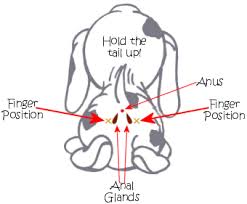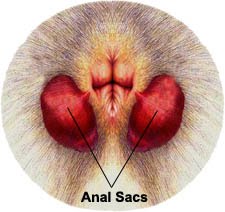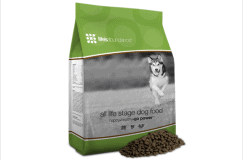Why Do Dogs Scoot Their Butts? Part 2
Nothing is worse that smelling the secretion of anal glands, or having to extract them. Even worse, having your precious pup spread that nasty stuff all over your carpet!
It is much more common is some breeds. But just for your quick education:
Dogs have two anal glands, positioned at around 10 o’clock and 2 o’clock on the “Anus Watch”. The anal glands sit just inside the rectum and create a nasty, musty, sickeningly odoriferous “gunk”. This “gunk” normally should express when your dog poops. If stools become abnormal (too soft, diarrhea, too hard) – the normal expression of these glands can be interrupted; they can become too full, and result in the dog scooting its butt across the floor trying to relieve the over full glands.
Unfortunately, this entire anal gland experience usually gets many owners into a trap of having the anal glands expressed repeatedly. Actually, too much expression of the anal glands actually results in trauma and irritation to the gland, much like popping a zit. The expression of the gland can actually drive fecal bacteria into the gland opening as well, resulting in an anal gland infection or a more serious anal gland abscess.

(There are situations of course, in which veterinarians should the express the anal glands. However, the majority of dogs out there should not have this routinely done.) In some RARE situations, the glands may not be placed correctly. I had one that was tilted wrong, and a vet had to do surgery, after that…all was well!)
Nobody wants the “Boot Scootin’ Boogie” going on in their home, so Holistically – I have found great ways to “deal and heal” faster and easier. As soon as you see the scooting begin, grab a bottle of our “Wound Care” blend and dab it gently on the anus with a clean, cotton cloth. Not only with this moisturize, soothe, and take out any “itchiness”, it will mask the anal gland smell, and deodorize any areas where the anus has touched (floor, couch, etc). PLUS!, if there is an infection festering, this will address that as well. It is diluted enough for you to be able to take a q-tip, cover it with the Wound Care blend, and gently insert into the anus, with a slow, twisting motion, being careful to cover the areas where the anal sacs are located. You may apply the Wound Care Blend as often as needed.
But the BEST answer to anal glands, honestly, is a diet that is not only nutritionally complete, but is also species appropriate with a HIGH QUALITY protein, and includes the (ground) natural, meaty bone meal that our dogs were created to eat in their diet. If there is not enough substance and fiber to the stool, as it comes out, it will not empty the anal glands correctly.
How Your Pet’s Diet Can Contribute to Anal Gland Problems
How May Your Dog’s Current Diet be causing problems?
The grains in commercial pet food are allergenic and inflammatory. If your dog is experiencing recurrent anal gland issues, the first thing you should do is eliminate all grains from her diet. Stop feeding any food that contains corn, potato, oatmeal, wheat, chickpeas, rice or soy. (Try one the two mentioned above, preferably BARF—stands for Biologically Appropriate Raw Food) Also, these are phytoestrogens and will wreck havoc with your dog’s hormones and the first place you’ll notice it is in the skin and coat.
I also recommend you switch to a high-quality protein for your dog, as opposed to “meals”, or worse yet, cheap bean (legume) proteins being touted as “healthy” now in commercial foods. (raw diet will ensure you are getting HIGH quality proteins, not the cheap stuff in commercial dog foods…especially the “bean proteins”…they are not even a protein…it’s a legume! And dogs don’t need legumes! Cheap ingredients…it’s just the way commercial dog foods go to increase their bottom line.)
If your dog’s poop is frequently unformed, soft, or watery, his anal sacs aren’t getting the firm pressure they need to empty. Feeding your pet a balanced, species-appropriate diet will help to eliminate this (pun intended)
Many health concerns – including chronic anal sac problems — resolve naturally over time once an animal is eating a biologically appropriate raw/peleo diet.
And, what if your dog does create an abscess in the anal gland? There are many things that can help this situation. A vet may have to actually go in a do some surgery to correct the issue. The wound care blend mentioned above would be appropriate to treat topically after such a procedure.









3 Comments